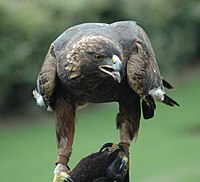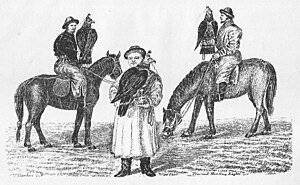Difference between revisions of "Field Guide/Birds/Aquila chrysaetos"
| Line 34: | Line 34: | ||
[[Image:Golden Eagle (small illustration).jpg|thumb|]] | [[Image:Golden Eagle (small illustration).jpg|thumb|]] | ||
| − | {{commons| | + | {{commons|Aquila chrysaetos}} |
There are five [[subspecies]] of Golden Eagle: | There are five [[subspecies]] of Golden Eagle: | ||
Revision as of 10:20, 13 May 2005
Template:Taxobox begin Template:Taxobox image Template:Taxobox begin placement Template:Taxobox regnum entry Template:Taxobox phylum entry Template:Taxobox classis entry Template:Taxobox ordo entry Template:Taxobox familia entry Template:Taxobox genus entry Template:Taxobox species entry Template:Taxobox end placement Template:Taxobox section binomial Template:Taxobox end
The Golden Eagle (Aquila chrysaetos) is one of the best known birds of prey in the world. Like all eagles, it belongs to the family Accipitridae.
Once the Golden Eagle lived in all temperate Europe, North Asia, North America, North Africa and Japan. In most areas this bird now is a mountain-dweller, but in former centuries it was also distributed in the plains and the forests.
There was a great decline in Central Europe, where the Golden Eagle now is restricted to the Alps. In Britain, there are about 500 birds left in the Scottish highlands. In North America the situation is not as dramatic, but there has been a noticeable decline as well. Efforts are also being made to re-introduce the species in Ireland, where they had been extinct since the early 20th Century. 35 birds have been released into the wild since 2001.
A pair of Golden Eagles build several eyries within their territory. They use them alternately for several years. The nest consists of heavy tree branches, upholstered with grass.
Old eyries may be 2 metres in diameter and 1 metre in height, as the eagles enlarge their nests every year. If the eyrie is situated on a tree it may happen that the supporting tree branches break because of the weight of the nest.
The female lays two eggs between January and May (depending on the area). After 45 days the youngs hatch. They are entirely white and are fed for fifty days before they are able to make their first flight attempts and eat on their own. In most cases only the older chick survives, while the younger one dies before leaving the eyrie.
The couple remains together for life. They often have a division of labour while hunting: one partner drives the prey to its waiting partner. The prey is marmots, hares and mice, sometimes birds, martens, foxes and young deer. Large mammals like chamois or adult deer can only be taken if they are wounded or sick.
Adult Golden Eagles have an average length of 75-85 cm (30-34"), a wingspan of 175-200 cm (70-80"), and a weight of 3 to 5 kg. As in all birds of prey, the females are generally slightly larger than the males.
In Central Asia, Golden Eagles sometimes are trained for falconry, and in Kazakhstan there are still hunters using these eagles in order to catch deer and antelopes.
There are five subspecies of Golden Eagle:
- Eurasian Golden Eagle (A. c. chrysaetos)
- American Golden Eagle (A. c. canadensis)
- Spanish Golden Eagle (A. c. homeryi)
- Japanese Golden Eagle (A. c. japonica)
- Russian Berkut (A. c. daphanea)
bg:Скален орел da:Kongeørn de:Steinadler eo:Reĝa aglo fi:Maakotka fr:Aigle royal fy:Keningsearn gl:Aguia real ja:イヌワシ lt:Kilnusis erelis nl:Steenarend pl:Orzeł przedni sv:Kungsörn



